Soviet Mission Control Center of Vostok and Voskhod times

I was prompted to write this article by this phrase by Philip Terekhov from his review of the Time of the First film:
“A separate interesting story with the Mission Control Center, as shown in the film. Alas, but the beautiful picture above is a copy of the American TsUPa ... The internal organization of the premises was so secret that you can only find imitations for films in the photo and video. ”
')
The remark was true, personally I also really wanted to know how our MCC looked like during the first manned flights. And I still managed to do it.
Of course, the MCC shown in the film has little to do with the real. But you can find photos of our real flight control center. More precisely, the coordination and computing center, as it was then called. Moreover, I am sure that Philip also saw him, but did not understand that it was he.
When I first saw him in the scenes from the Venus-4 film, I also did not believe that this was a real MCC, having taken it as a decoration. But the more I studied the available information, the clearer my mistake became.
For a start, a little dry history from the book TsNIIMasha:
“The work of TsNIImash on ballistic support for flight control of manned and automatic vehicles began in 1963. And it was a new and, to some extent, unexpected direction of the scientific activity of the institute. This direction originated in the institute with the arrival of the new director G.. Tyulin in 1959. He strengthened the composition of the Computing Center and equipped it with two M-20 machines. The director Yu.A. Mozzhorin, who came to NII-88 in 1961

COMPUTER M-20. Snapshot from the site: Virtual Computer Museum
The center was based on two computers of type M-20. Two semi-automatic data entry devices were installed in the NEC-88 ECC to automatically receive the results of the trajectory measurements coming from the measuring points, similar to those of the NII-4 ECC. In addition, a system for collectively displaying the received information was ordered and developed. On the central screen measuring 2 by 3 meters, various geographical maps and the flight path of the satellite against the map were projected, and the image of the satellite itself was given in the form of a glowing spot. The coordinates of the projection of the trajectory and the position of the satellite were issued by an electronic computer that processes the results of current trajectory measurements. On two additional screens measuring 1x1.5 meters placed on both sides of the main screen, static information characterizing the accompanying flight was displayed: charts, tables, and on a separate TV set - television information from the Baikonur cosmodrome on the launch and flight of the launch vehicle images of astronauts during the flight ".
Then I corresponded with the now deceased IMP mathematician Alexander Konstantinovich Platonov and, to check myself, I asked him about the early MCC, attaching a few photos. Given his work, Platonov was there. He confirmed my suspicions and sent a lot of useful information, the analogues of which I could not find anywhere.
Here is what Alexander Konstantinovich wrote about the creation of the MCC:
“Later, when Yu.K. Khodarev made the famous Yevpatoriysky point of distant space communications, the Police appeared to transmit the received radio data. These data and all the telemetry on channels began to come to TsNIIMash. Therefore, our gatherings strongly moved there. There, at first, the hall described by me above with a separate room for the authorities, but later all the ballistics began to sit in their room, and the Office Hall became similar to what is in your picture. I remember both the big screen and the running clock over it.
We were commanded by Mikhail Aleksandrovich Kazansky, who was very significant in the history of Soviet space. His task was to form the procedure for performing the next ballistic calculations, to perform a comparison of our results and, most importantly, to provide filtering of messages to the control room in terms of their reliability and timeliness. He was a very seasoned servant to the tsar, and by responsibility he was the father to his ballistic soldiers. Thanks to him, the ballistic control group worked in unison, without blunders, like a clock.
I remembered him because I was constantly convincing him that our work (and it was to write out on the phone the data of operational calculations transferred from the EC, to interpret them and transfer some of them to the control room) - we need to somehow automate it.
One way or another, further development of control automation led to the fact that several television sets were installed in the control room (probably more for solidity - they usually had a setup picture on their screens), and later a reading chamber was placed in our ballistic room. It was put handwritten text, which then see in the control room with its televisions and telephones.
Much later, the Ariston screen appeared under the digital clock in the control room. It was said that with this “Ariston” Shvernik’s niece had solved the acute problem of showing a TV program on the big screen. This was realized with the help of a mirror in the form of a rotating disk with oil poured on it, the profile of which was changed by the electric field generated by the TV signal. A powerful beam of light illuminated this disk, and the relief of such a liquid mirror formed on the screen a reflection of the desired TV image. All the equipment was behind the screen, and the image was shown "to the light".
On the huge screen of “Ariston” in this room, we watched the intercepted Apollo 11 program with their jumps on the Moon in a narrow circle of guests. ”
Since this MCC began work in 1963, it is not surprising that I found its first shots in a film dedicated to the joint flight of Bykovsky and Tereshkova on spacecraft Vostok-5 and Vostok-6. This flight took place on June 16-19, 1963.

Having looked at him for the first time, it is difficult to believe that this is the MCC. Too it is different from modern. More like a television studio. But the central screen is clearly visible 2 meters by 1 meter, as well as two side ones. Alexander Konstantinovich also recognized him. So it was he, it was through this MCC that the last "Vostoks", "Sunrises" and the first "Unions" were controlled. As well as interplanetary stations of the 60s. And in general, perhaps, it is well conveys the spirit of the time when they first began to fly into space, but many nuances have not yet been developed or invented.
It is very interesting that in the hall there was a globe of the moon.
Side screen close-up:
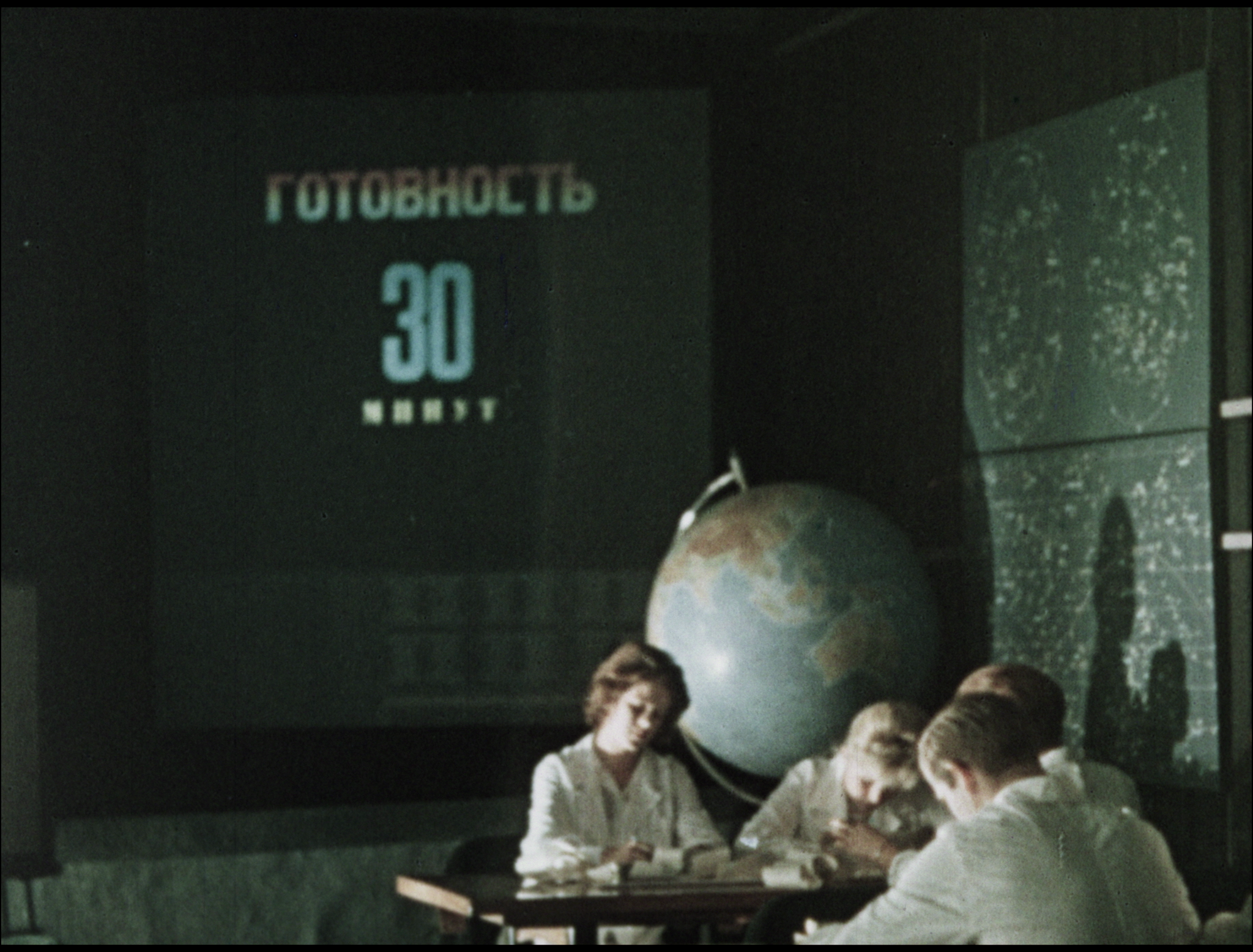
The girls in front of the screen are busy with something interesting:
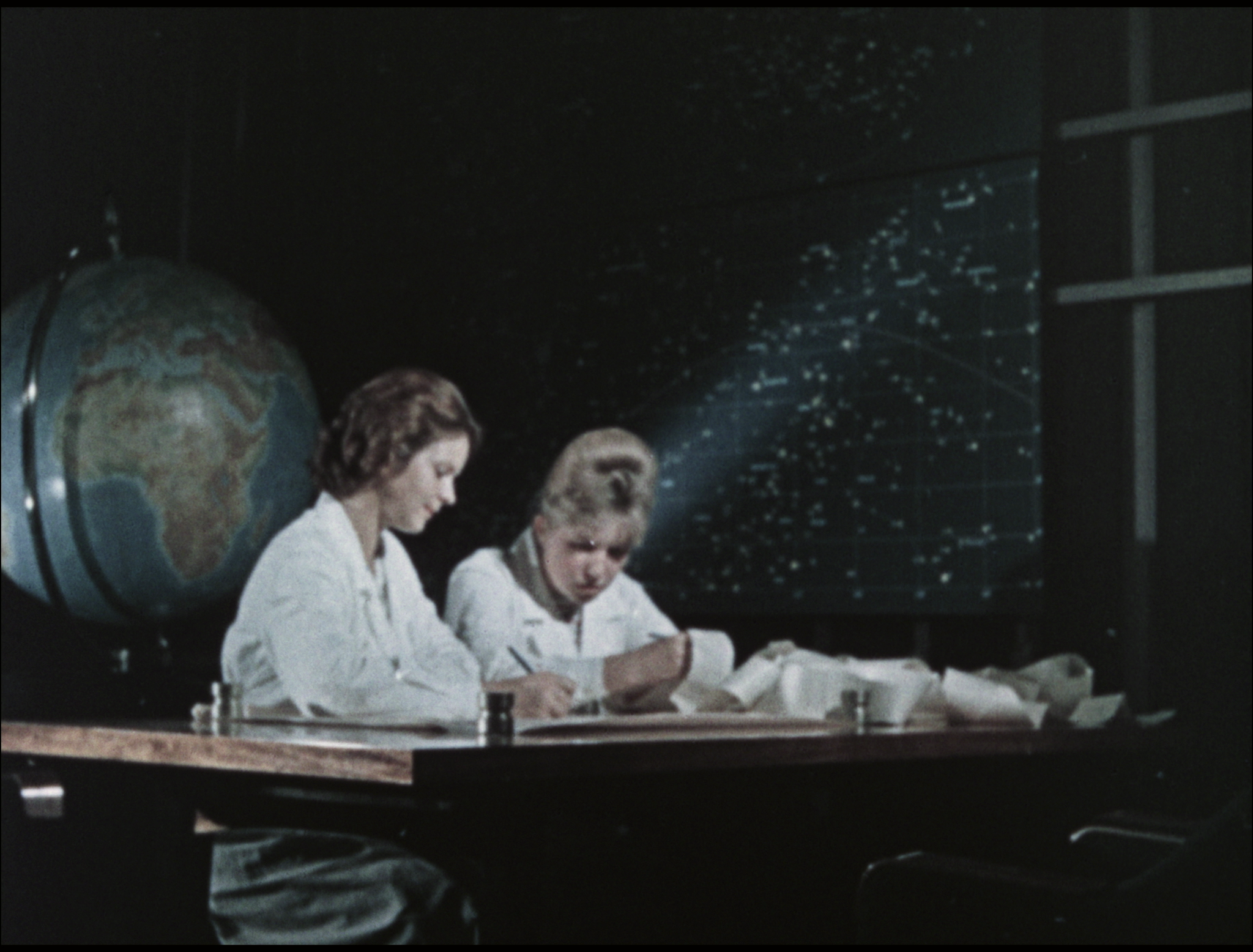
Most likely, they have in their hands a tape with a printout of information issued by a computer. It is also interesting to note the globe of the Earth and the map of the starry sky.
The next slide shows how the information display system works. In this case, showing the parameters of the orbit:
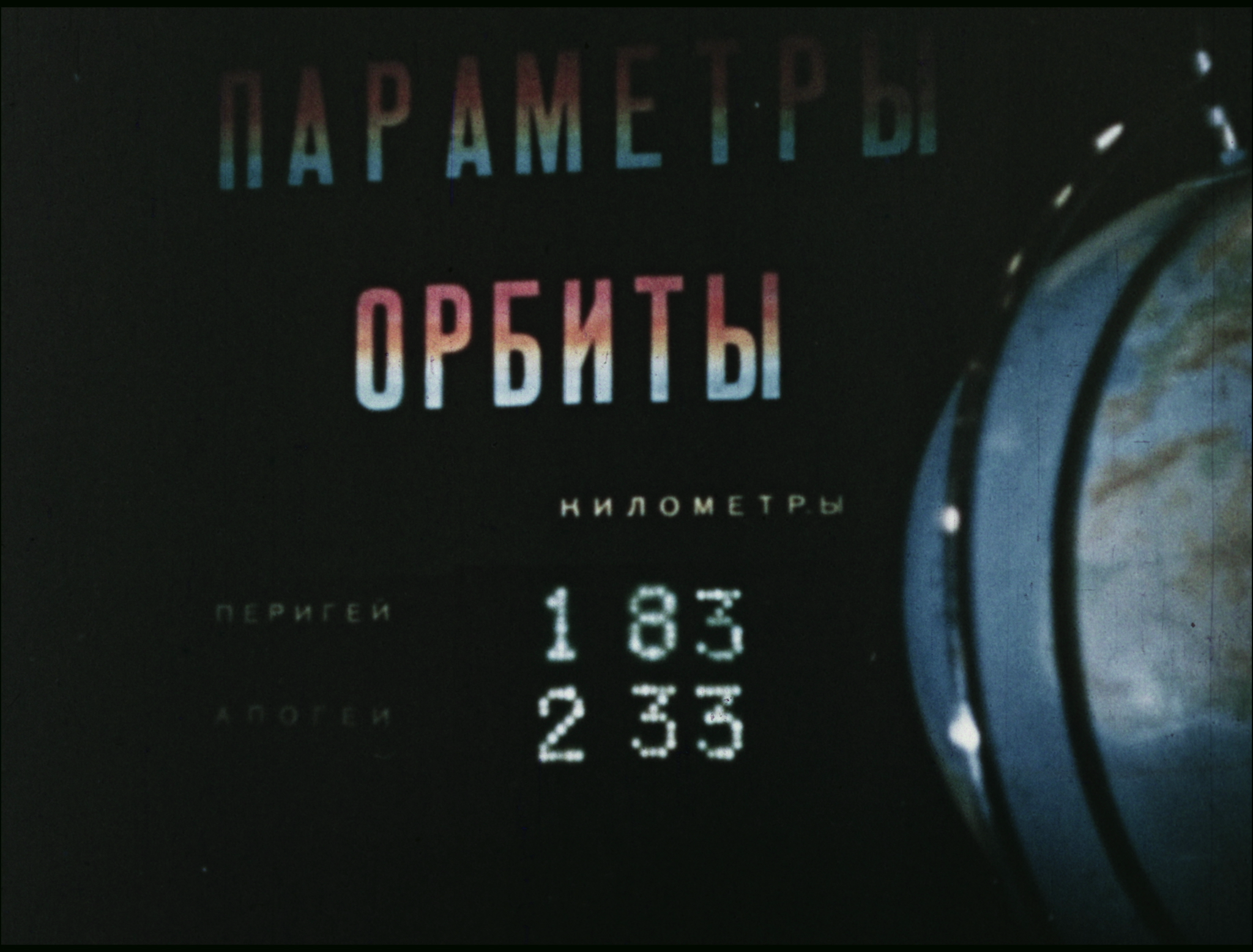
An example of changing the map on the central screen. The first option, see a little higher. Initially, there was a map of the Soviet Union with a projection of the missile launching trajectory. After the change of the projection to the Mercator one, the mapping of the ship’s orbit relative to the Earth began.
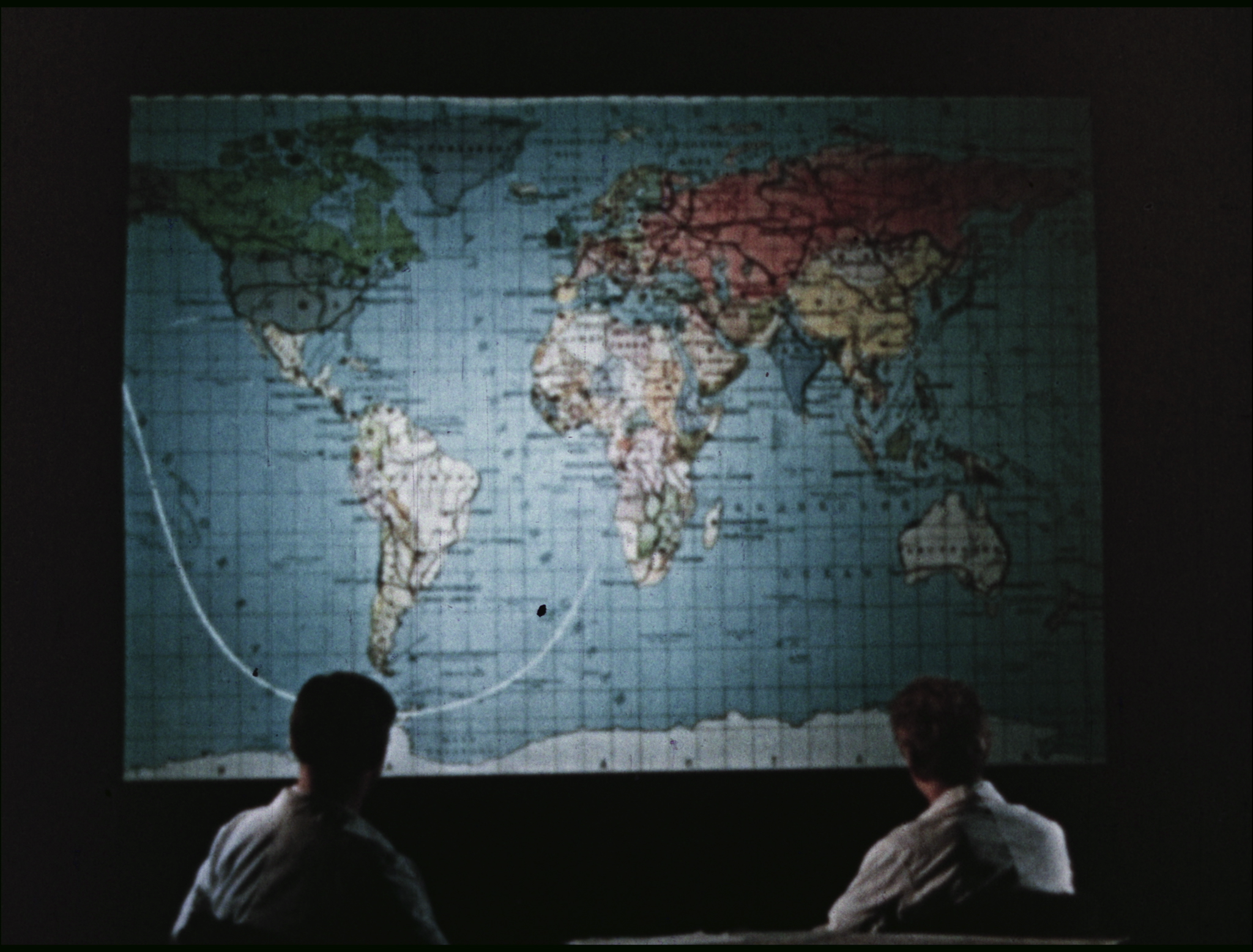
Another view:
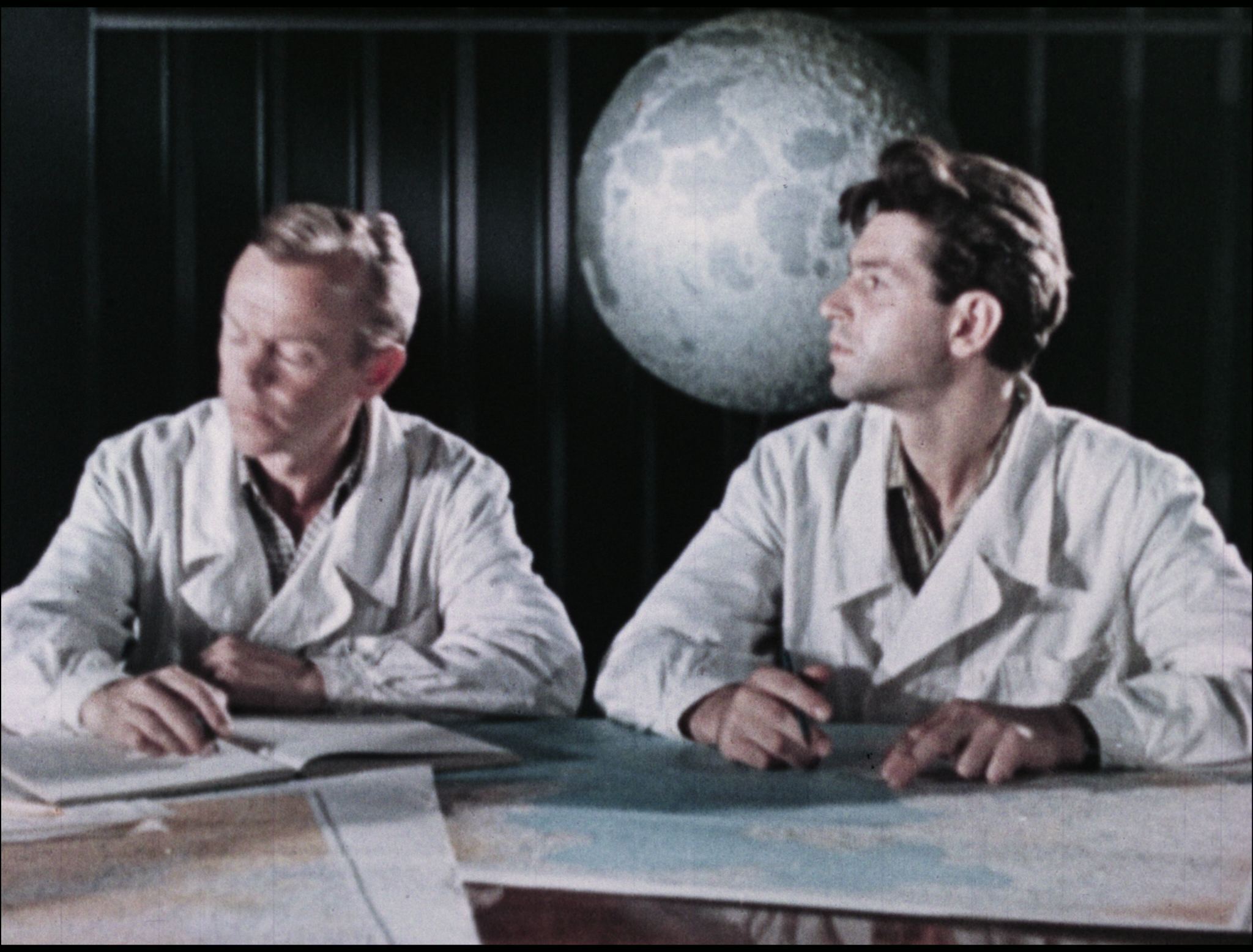
Here is a snapshot of the same MCC, but from a 1967 film dedicated to Venus 4:
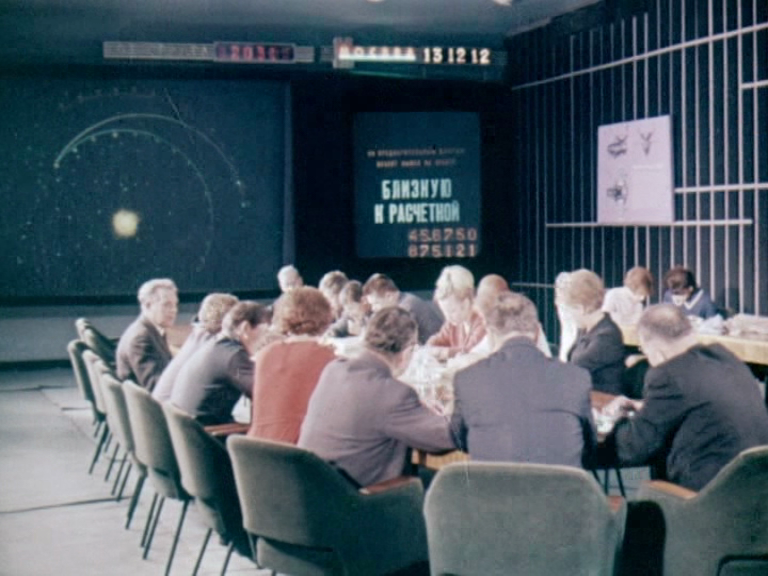
Since 1963, the hall is clearly slightly modified. At the top of the screens you can see an electronic clock and a timer. The central screen, this time, shows the trajectory of the flight to Venus. The globe has disappeared. The girls moved a little to the side, and on the wall is a poster with the layout of the AMC "Venera-4".
A little better room can be considered in black and white picture from the official site of TsNIIMash.
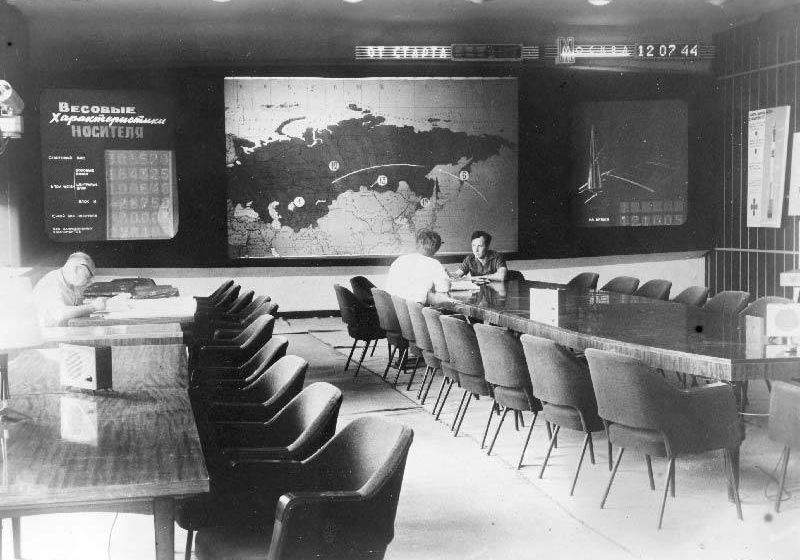
On the walls - posters with the image of one of the modifications of the "seven". On the central screen is a map of the USSR with NPCs. On the left screen displayed weight summary of the media during the withdrawal. Words are difficult to make out. But one of the lines is clearly “Block L” or “Block I”.
Inference trajectory is very similar to the real one with an inclination of 65 degrees. The route of the flight just passes near the Kura range in Kamchatka. True, the left side of the trajectory is smeared. The track starts somewhere over Tomsk. At the same time there is a mark near Baikonur.
You can compare with the real route when breeding "Voskhod-2":
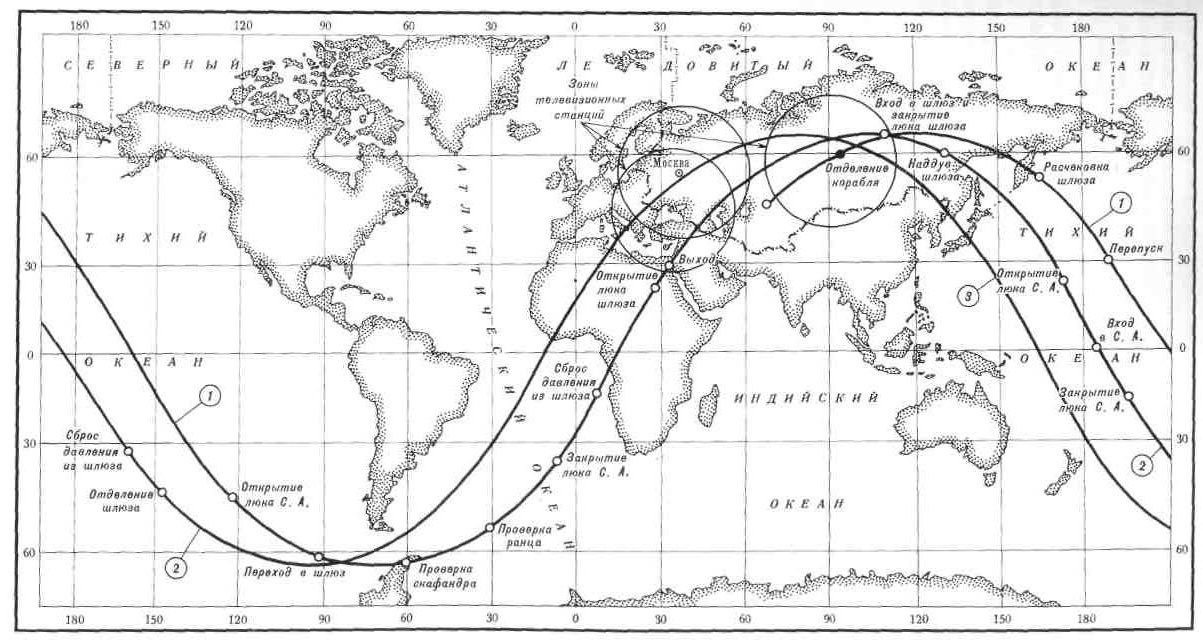
It is also clear that the frame from the film about “Vostok-5/6” shows exactly this orbit.
The last frame with this MCC, which I found, refers to Lunokhod-1, which landed on the moon on November 17, 1970:
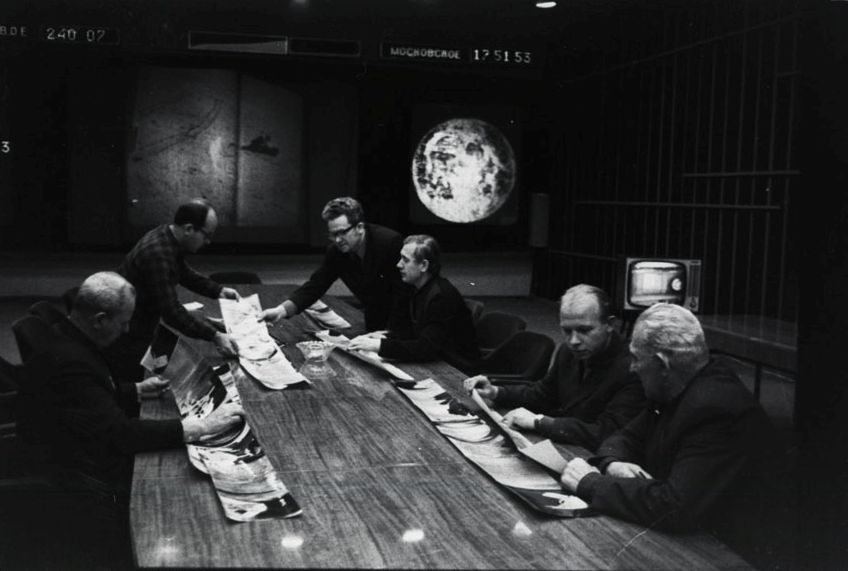
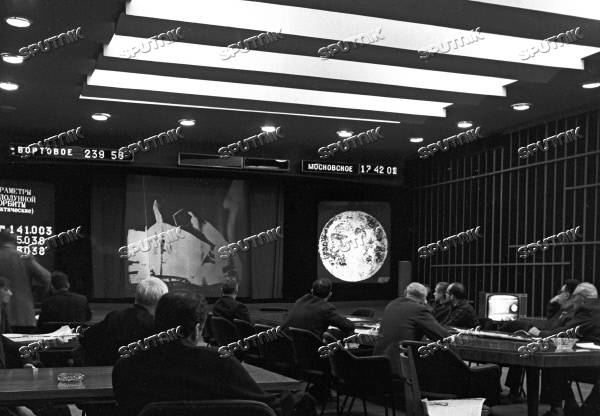
There is a working meeting. The “Ariston” screen has already been mounted, and through it is a projection of a part of the “Lunokhod” panorama. On the table laid out printed panoramas of the moon. Apparently, it was Lunokhod-1 that was the last device with which this control center worked.
In December 1970, the new coordination and computing center TsNIIMash was commissioned. After that, the control of the ships and interplanetary stations gradually passed to him. He works to this day.
PS However, the history of the Soviet TsUPov is not limited to them. The fact is that before TsUPa in TsNIImash there was also a similar one in NII-4. There, too, was the processing on the computer M-20 and the projection on the screens. He is also mentioned in the book TsNIImash. But MCC NII-4 was much more secret. Unlike the "civil" TsUPa TsNIIMash, it was originally intended for the Strategic Missile Forces.
So, as you can see, there are not so many materials. But there is.
An interesting fragment from the memoir of Mozzhorin about a visit to this TsUPa (tentatively in 1959-1960) by Marshal of Artillery V.F. Tolubko:
“We went to inspect the coordination and computing center. Now, I think, they will look for “window dressing”. I ordered to show the display of KIK's work on a large color screen in full, and began to explain the essence of the shown. Tolubko listened attentively and asked a question with the ehidtsey:
- And where is the “kersey boots”?
He was referring to an anecdote about an air defense system, where enemy aircraft were shown on a large screen, moving with the help of soldiers who received instructions by telephone. And from under the screen were visible tarpaulin boots advertised "automation". I calmly explain:
- Everything that you see on the color big screen: the trajectory of the satellite, its movement - all this is calculated by the computer-20, you can believe me. But the NPC “blinked” - the reception of telemetric information began. Then “kersey boots” came into effect, but they sit in the next room and turn on the flashing light on the telephone command from the point. Of course, it would be possible to automate this operation as well so that the flasher should be included from the measuring point, but these are the same “kersey boots”, however, they are more expensive and add nothing to the automation of the display. On the basis of such a mapping principle, screens can be built at the command posts of the rocket forces in order to monitor the readiness of the missiles and the missile situation.
“They also say that no screens are needed on the crews of the missile troops,” Tolubko expressed his late indignation to someone. ”
But again, much more vivid memories were left by Platonov:
“After the launch of the first satellites, the control processes were transferred to NII-4 in Bolshevo (they, headed by PE Elyasberg, were responsible for issuing target indications to all observation points). And so, at the very first of the unsuccessful flights to Mars, I (answering from our BC for the questions of correction and other control operations on the trajectory) turned out to be in the first Real Management Hall in my life! He made a big impression on me - first and foremost.
First impression: a large hall with one or two tables with telephones at the entrance (GS Narimanov, head of the space affairs NII-4, one of the many very cultured military people I met in my life, and KD) sat behind them. Bushuev — Korolev’s deputy, immaculately calm and business-like, looks sternly, but speaks without pressure and on business), and then behind them a long, translucent wall of this hall, below the ceiling, with a map of the world on it and soldiers translucent behind it which put marks of points and trajectories on this map.
And in front of the wall and to the windows of the opposite side of the hall there are two or three rows of identical oak-plywood operator consoles with a semicircular table notch, telephones and a high table stand with a clock and two rows of some switch instruments.
The first impression was respectful: I realized that this was given to us by the flight control room of completely different products.
We, the ballistics, were given a place at the rear and farthest diagonally from the entrance by the console. And so we sat there three together - with Leonid Shevchenko, a ballistic researcher from NII-4, and with Alexander Dashkov, a ballistic from Korolev (the joint venture at the meetings jokingly called him “Graf Dashkov.” was the person who, together with his subordinate Slava Ivashkin, found an amazingly beautiful random (not associated with celestial mechanics, but simply a gift of a ballistic case) the property of the lunar vertical nullifying the possible terrible 20 m / s lateral speed with verti cial "soft" landing on the moon, what is actually saved by closing the project "E-6".
And so we sat down, and here I, with tremendous surprise and disappointment, found that there was a clock on the remote, and the rest of the instruments with arrows were painted! I went to look at other consoles - everything is real there! In a word, on this most distant and perhaps not the most necessary console, made according to the laws of symmetry and beauty of the hall, in case the generals look from afar, these missing devices were simply drawn.
So we sat for a number of months at this remote control at SRI-4. And it was the era of “Monday on Saturday” by the Strugatsky brothers with their scientific research institutes FAQ and Scientific Research Institute KOVO.
Find photos of this MCC is quite difficult. I found only a few pictures that may have been taken exactly in it.

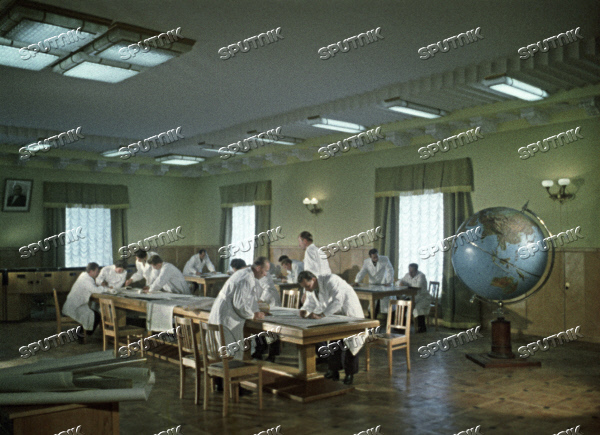
You can understand that the last picture was taken in the same room, by fluorescent lamps. This PMU differs markedly from the Central Research Institute of Maslovic Science, but there are certain common features.
Unfortunately, I could no longer clarify with Alexander Konstantinovich whether he saw the premises at one time.
PPS I also wanted to note that I completed the layout of the first book about the exploration of the moon. Read more here.
Source: https://habr.com/ru/post/446098/
All Articles